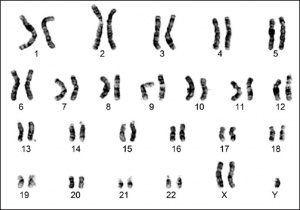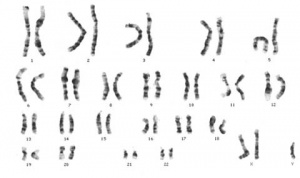Klinefelter syndrome
| Embryology - 27 Apr 2024 |
|---|
| Google Translate - select your language from the list shown below (this will open a new external page) |
|
العربية | català | 中文 | 中國傳統的 | français | Deutsche | עִברִית | हिंदी | bahasa Indonesia | italiano | 日本語 | 한국어 | မြန်မာ | Pilipino | Polskie | português | ਪੰਜਾਬੀ ਦੇ | Română | русский | Español | Swahili | Svensk | ไทย | Türkçe | اردو | ייִדיש | Tiếng Việt These external translations are automated and may not be accurate. (More? About Translations) |
LD50.3 Klinefelter syndrome
| ICD-11 LD50.3 Klinefelter syndrome |
|---|
|
Introduction
Klinefelter syndrome (47,XXY, XXY syndrome or condition, XXY trisomy) affects male physical and cognitive development. The extra copy of genes on the X chromosome interferes with male sexual development and can prevent the normal function of the testis testes, reducing the levels of testosterone. The signs and symptoms vary among affected individuals.
Rare variations include 47,XXY/46,XY (mosaic syndrome) and Poly-X Klinefelter syndrome: 48,XXYY (or tetrasomy), 48,XXXY (or tetrasomy) and 49,XXXXY (or pentasomy).
First described in 1942 by Dr Harry Klinefelter.[1]
Genital System - Abnormalities
Some Recent Findings
|
| More recent papers |
|---|
|
This table allows an automated computer search of the external PubMed database using the listed "Search term" text link.
More? References | Discussion Page | Journal Searches | 2019 References | 2020 References Search term: Klinefelter syndrome | karyotype 47,XXY |
| Older papers |
|---|
| These papers originally appeared in the Some Recent Findings table, but as that list grew in length have now been shuffled down to this collapsible table.
See also the Discussion Page for other references listed by year and References on this current page.
|
Features
Affects male physical and cognitive development. Small testes that do not produce as much testosterone as usual.
- delayed or incomplete puberty, breast enlargement (gynecomastia), reduced facial and body hair, and an inability to have biological children (infertility).
- Some affected individuals also have genital differences - undescended testes (cryptorchidism), (hypospadias), or an unusually small penis (micropenis).
- Children may have learning disabilities and delayed speech and language development. Tend to be quiet, sensitive, and unassertive, but personality characteristics vary among affected individuals.
- Older children and adults tend to be taller than their peers.
(Text modified from Genetics Home Reference - Klinefelter syndrome)
Diagnosis

Cytogenetics Tests
- Karyotyping
- FISH-interphase
Molecular Genetics Tests
- Detection of homozygosity
- Deletion/duplication analysis
- Targeted variant analysis
- Sequence analysis of the entire coding region
48,XXYY and 48,XXXY
Much less frequent variants
- 48,XXYY - 1 per 17,000 male births.
- often tall, may have an eunuchoid habitus with long legs, sparse body hair, small testicles and penis, hypergonadotropic hypogonadism, and gynecomastia. IQ level is in the range of 60–80, with delayed speech.
- 48,XXXY - 1 per 50,000 male births.
- prone to hyperactivity, aggression, conduct, and depression compared to males with 47,XXY.
References
- ↑ Klinefelter HF. Reifenstein EC. and Albright F. Syndrome characterized by gynecomastia aspermatogenes without A-Leydigism and increased excretion of follicle stimulating hormone. (1942) J Clin Endocrinol Metab. 2:615–627.
- ↑ Tanner M, Miettinen PJ, Hero M, Toppari J & Raivio T. (2021). Onset and progression of puberty in Klinefelter syndrome. Clin Endocrinol (Oxf) , , . PMID: 34523156 DOI.
- ↑ Balercia G, Bonomi M, Giagulli VA, Lanfranco F, Rochira V, Giambersio A, Accardo G, Esposito D, Allasia S, Cangiano B, De Vincentis S, Condorelli RA, Calogero A & Pasquali D. (2019). Thyroid function in Klinefelter syndrome: a multicentre study from KING group. J Endocrinol Invest , 42, 1199-1204. PMID: 30912057 DOI.
- ↑ Akcan N, Poyrazoğlu Ş, Baş F, Bundak R & Darendeliler F. (2018). Klinefelter Syndrome in Childhood: Variability in Clinical and Molecular Findings. J Clin Res Pediatr Endocrinol , 10, 100-107. PMID: 29022558 DOI.
- ↑ Shamsi MB, Kumar K & Dada R. (2011). Genetic and epigenetic factors: Role in male infertility. Indian J Urol , 27, 110-20. PMID: 21716934 DOI.
Reviews
Bearelly P & Oates R. (2019). Recent advances in managing and understanding Klinefelter syndrome. F1000Res , 8, . PMID: 30755791 DOI.
Giudice MG, Del Vento F & Wyns C. (2019). Male fertility preservation in DSD, XXY, pre-gonadotoxic treatments - Update, methods, ethical issues, current outcomes, future directions. Best Pract. Res. Clin. Endocrinol. Metab. , , . PMID: 30718080 DOI.
Kanakis GA & Nieschlag E. (2018). Klinefelter syndrome: more than hypogonadism. Metab. Clin. Exp. , 86, 135-144. PMID: 29382506 DOI.
Los E & Ford GA. (2019). Klinefelter Syndrome. , , . PMID: 29493939
Gravholt CH, Chang S, Wallentin M, Fedder J, Moore P & Skakkebæk A. (2018). Klinefelter Syndrome: Integrating Genetics, Neuropsychology, and Endocrinology. Endocr. Rev. , 39, 389-423. PMID: 29438472 DOI.
Lanfranco F, Kamischke A, Zitzmann M & Nieschlag E. (2004). Klinefelter's syndrome. Lancet , 364, 273-83. PMID: 15262106 DOI.
Articles
Juel Mortensen L, Lorenzen M, Jørgensen N, Andersson AM, Nielsen JE, Petersen LI, Lanske B, Juul A, Hansen JB & Blomberg Jensen M. (2019). Possible link between FSH and RANKL release from adipocytes in men with impaired gonadal function including Klinefelter syndrome. Bone , 123, 103-114. PMID: 30914274 DOI.
Foland-Ross LC, Ross JL & Reiss AL. (2019). Androgen treatment effects on hippocampus structure in boys with Klinefelter syndrome. Psychoneuroendocrinology , 100, 223-228. PMID: 30388596 DOI.
Sakurai T, Iizuka K, Kato T & Takeda J. (2019). Type 1 Diabetes Mellitus and Klinefelter Syndrome. Intern. Med. , 58, 259-262. PMID: 30146555 DOI.
GRIGNON CE & GRIGNON J. (1947). [Not Available]. Union Med Can , 76, 1254. PMID: 18899536
SUSMAN E. (1947). Reifenstein-Klinefelter-Albright syndrome. Med. J. Aust. , 2, 155. PMID: 20344569
BETTINGER HF & ROBINSON B. (1946). The Klinefelter-Reifenstein-Albright syndrome. Med. J. Aust. , 2, 446-9. PMID: 21002506
Search PubMed
Search Pubmed: Klinefelter syndrome
External Links
External Links Notice - The dynamic nature of the internet may mean that some of these listed links may no longer function. If the link no longer works search the web with the link text or name. Links to any external commercial sites are provided for information purposes only and should never be considered an endorsement. UNSW Embryology is provided as an educational resource with no clinical information or commercial affiliation.
- Genetics Home Reference Klinefelter syndrome
Glossary Links
- Glossary: A | B | C | D | E | F | G | H | I | J | K | L | M | N | O | P | Q | R | S | T | U | V | W | X | Y | Z | Numbers | Symbols | Term Link
Cite this page: Hill, M.A. (2024, April 27) Embryology Klinefelter syndrome. Retrieved from https://embryology.med.unsw.edu.au/embryology/index.php/Klinefelter_syndrome
- © Dr Mark Hill 2024, UNSW Embryology ISBN: 978 0 7334 2609 4 - UNSW CRICOS Provider Code No. 00098G

